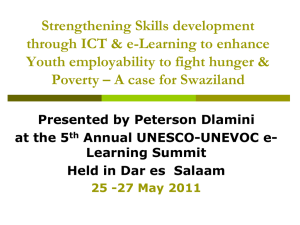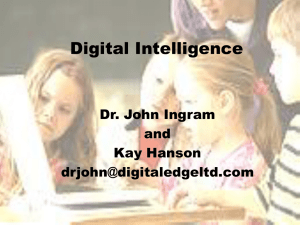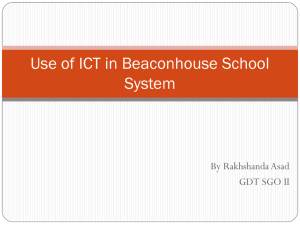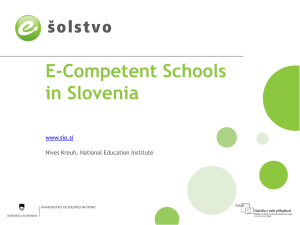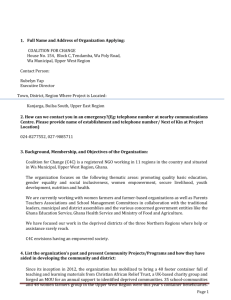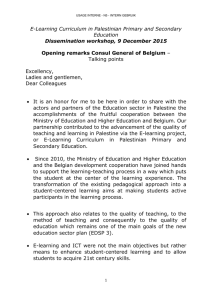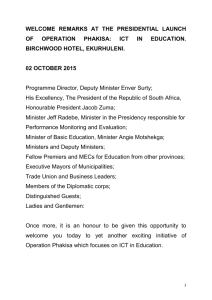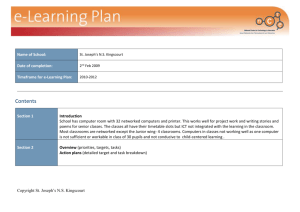Eastern Cape Education e-Learning Implementation Strategies
advertisement
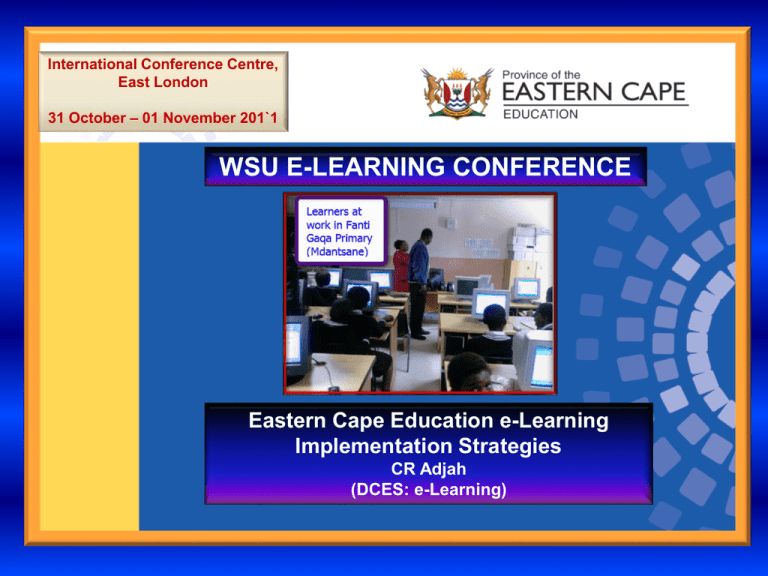
International Conference Centre, East London 31 October – 01 November 201`1 WSU E-LEARNING CONFERENCE Eastern Cape Education e-Learning Implementation Strategies CR Adjah (DCES: e-Learning) Introduction “If you just build it, they won’t come – you need to shape users’ behaviour by acknowledging their world view rather than your own as a technology implementer”. (Tom Haynes, 2008) What is the reality? •The 3-E Strategy •Evident – useful for easy life •Easy to use – avoid feelings of inadequacy •Essential – to carry out ones job Concerns Technology transforming learning poses concerns to educators How to •improve on ways to engage learners f2f or online • become part of advanced pedagogical discussions not readily transferable • become users of technology and social networking • avoid social element of learning being replaced by technology Change Pressure Pressure influencing educational design: •Transition from industrial era to information era. Global •Shift from national perspective to global perspective. Social The process of knowledge production is towards social models Educational Increase in collaboration between educators, schools within and outside the country Change Pressure Technological Technology: •present in all aspects of society •controls information creation, sharing and interactions •participative web “Web 2.0”, mobile phones, social networking services, netbooks Components and Processes of Learning Components •Social •an emergent property of interactions between networks of learners •Situated •activities mirror actual situations •Reflective •time for learners to assimilate new information •Multi-faceted •engaging, active construction Process Self-paced Guided Cohort Changing Web Tools EC Implementation Strategies ICT Infrastructure Models 3 Provincial ICT centres: Tapping into •ELI, •Algoa, •Trinset Provincial Curriculum Website: www.eccurriculum.co.za - Curriculum related information HR Collaboration: • E-Learning Personnel • CIMS Personnel • IT Unit • Curriculum Planners • MSTE Coordinators EC Implementation Strategies 1 ICT centre per district: 23 ICT centres established •Training, •Planning, •Development of Website HR Collaboration: •E-Learning Specialists •CIMS •IT •Subject Advisors •MSTE Coordinators ICT Resources: 3 School ICT Models: •30 student & 1 facilitator workstations, 1 server, 1 Printer, •ICT centre 1 Screen •Laptop solution •1 Laptop, Projector, Screen •Mobile ICT Lab • 1 trolley with 24 Laptops, Projector, screen Resourcing School ICT Centres Laptop Solution Mobile Lab Mobile Science Lab Software 500 schools 700 schools 0 61 High schools 2500 licensing to schools Changing Web Tools Training Principals: Management of ICT resources & school management (EMIS) Teachers: enhance capability in teaching and assessment Integrate ICT in teaching, learning, assessment and management E-Content resourcing licensed and free software provision to enhance optimal use of ICT hardware Material Development: Promote instructional design For LMS that are SCORM complaint Social Partners 1. 2. 3. 4. 5. 6. Vodacom- POC, resourcing and connectivity MTN – Resourcing and connectivity SchoolNet – Capacity building Fort Hare – Fort Beaufort NMMU- PE and Uitenhage Nokia- MoMaths • Pilot 6 schools in 2010 • Extended to 61 schools with Dinaledi project 7. IBM – SmartKids to support multigrade teaching in 50 Foundation phase schools in 2 Districts (Uitenhage & KWT) 8. IBM- Reading Companion for primary schools 9. Telkom Foundation schools 10. Educ Beyond Borders (Canada) – capacity building Challenges & Recommendations Challenges Budget cuts/Funding Connectivity Physical infrastructure Government Red tapes No follow up at the end Pilot projects Too many small-scale projects piloted Recommendations Change in the mindset of Senior managers towards issues around nonimplementation of e-Learning on a large scale THANK YOU!!!!!!




